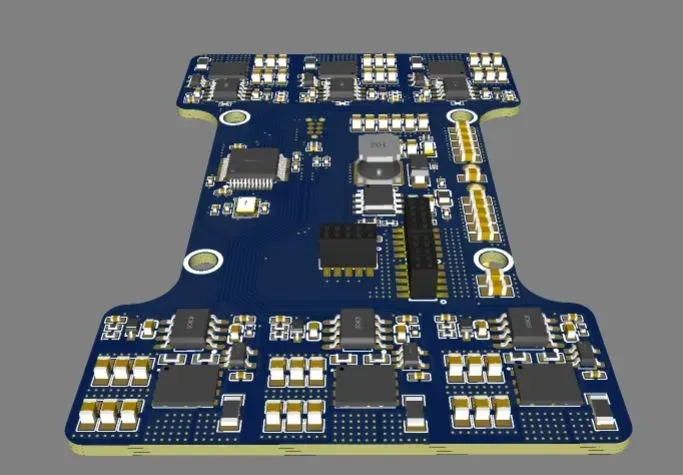 Ongoing
OngoingFlight Controller Design 2.1 - ESCs
STDFlight Controller Design 2.1 - ESCs
License
:TAPR Open Hardware License
Description
Dual ESC Hardware Overview
This is a compact, dual-channel Electronic Speed Controller (ESC) designed to drive two independent 3-phase brushless motors using a single STM32G431CBT6 microcontroller. Each ESC channel includes its own power stage, current and voltage sensing, and input PWM/DShot control. The design supports both sensorless and sensored BLDC or FOC (Field-Oriented Control) operation.
The ESC is intended to be used in modular, stackable multirotor systems. Two ESC boards can be physically stacked to form a complete quadcopter ESC solution supporting four motors. A shared 12.6 V input power rail is distributed across the modules via 1.27mm header interconnects.
One ESC board provides a regulated 3.3 V output (via onboard LDO or switching regulator), supplying power to an externally mounted flight controller (FC). This eliminates the need for a separate power module. The FC connects directly to the top of the ESC stack and interfaces via standard signal headers for motor control and telemetry communication.
Key features include:
- Dual BLDC motor drive per module, compatible with DShot and PWM protocols
- Stackable design for 4-motor configurations (e.g., quadcopters)
- Shared 12.6 V power distribution between modules via backplane or board-to-board connectors
- Integrated 3.3 V buck converter on one module to power the FC
- Flight controller 1.27mm header interface
Microcontroller Unit (MCU)
- Model: STM32G431CBT6 (STMicroelectronics)
- Core: ARM Cortex-M4 @ 170 MHz with FPU
- System Clock: 16 MHz external crystal oscillator
- Purpose: Central controller for both ESCs; generates PWM, reads sensors, runs FOC or trapezoidal control.
Power Supply (Buck Converter)
- IC: TPS5430DDAR (Texas Instruments)
- Input Voltage (VIN): 12.6 V (designed for 3S)
- Output Voltage (VOUT): 3.3 V
- Purpose: Powers the MCU and logic circuits
MOSFET Power Stage
- FET Model: BSC0924NDI (Infineon)
- Quantity: 6 x 2 N-channel MOSFETs (3 per ESC)
- Configuration: Three half-bridges per motor
- Key Specs:
-
- R_DS(on) ≈ 3.7 mΩ
- V_DS max = 30 V
- Current - Continuous Drain(Id) = 40A
Gate Drivers
- Model: IR2103STRPBF (Infineon)
- Quantity: 6 drivers (3 per motor, each driving one half-bridge)
- Features:
-
- High-side and low-side drive
- Bootstrap operation
Voltage Sensing
- Method: Voltage divider
- Ratio: 10kΩ / (10kΩ + 47kΩ) = ~0.175
- Equation:
-
- V_MCU = V_PHASE × 0.175
- Purpose: Phase voltage monitoring for sensorless control, protection
Current Sensing
- Shunt Resistor: 1 mΩ
- Amplifier: INA180A3IDBVR (Texas Instruments)
-
- Gain: 100 V/V
- Output to MCU:
-
- V_MCU = I_PHASE × 0.1 V/A
- Power Limit: ~1 W → Max current ≈ 30 A
ESC 1 Pin Assignments
| Signal | MCU Pin |
|---|---|
| LED1 | PA12 |
| PWM_IN_1 | PB6 |
| HIN_1A (PWM A) | PA8 |
| HIN_1B (PWM B) | PA9 |
| HIN_1C (PWM C) | PA10 |
| V_SENSE_1A | PB2 |
| V_SENSE_1B | PB12 |
| V_SENSE_1C | PB15 |
| I_SENSE_1A | PB11 |
| I_SENSE_1B | PB14 |
| I_SENSE_1C | PB1 |
ESC 2 Pin Assignments
| Signal | MCU Pin |
|---|---|
| LED2 | PA11 |
| PWM_IN_2 | PB9 |
| HIN_2A (PWM A) | PB10 |
| HIN_2B (PWM B) | PA1 |
| HIN_2C (PWM C) | PA0 |
| V_SENSE_2A | PA6 |
| V_SENSE_2B | PA4 |
| V_SENSE_2C | PA2 |
| I_SENSE_2A | PA7 |
| I_SENSE_2B | PA5 |
| I_SENSE_2C | PA3 |
Programming / Debugging Interface
- Connector: Tag-Connect TC2030
- Interface: SWD (Serial Wire Debug)
Design Drawing
 The preview image was not generated, please save it again in the editor.
The preview image was not generated, please save it again in the editor.BOM
 Bom empty
Bom empty Clone
CloneProject Members
 Empty
Empty


Comment